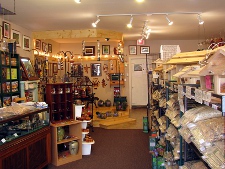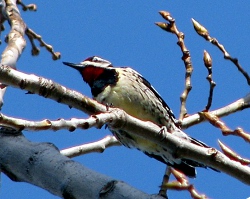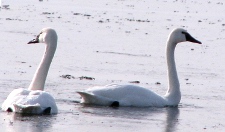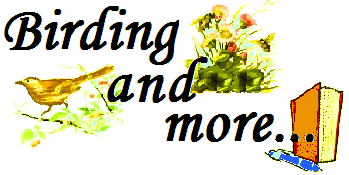 Newsletter
Newsletter
2010
/ Issue 7
IN THIS ISSUE: THE STORY OF ONTARIO'S MAGNIFICENT FISH HAWK: THE OSPREY
ONTARIO'S MAGNIFICENT FISH HAWK
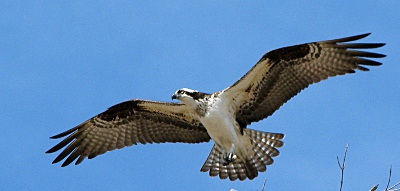 and
comparable in overall size to the Turkey Vulture. These birds have a
dark brown back and are white underneath, with a distinctive brown
eye-stripe. Osprey feed almost exclusively of freshly caught fish.
During the nesting season, the male does almost all of the hunting. In
dramatic fashion the Osprey will plunge into the water and grab the fish
(this can be witnessed frequently during the late Spring and Summer on
the Moira River near Memorial Park). The Osprey have sharp spines on the
soles of their talons which helps them to keep a grip on their slippery
prey. In flight, the Osprey will rotate the fish so that it's pointing
forward for better aerodynamics. The male will eat the head of the fish
and then bring the body back to the nest
and
comparable in overall size to the Turkey Vulture. These birds have a
dark brown back and are white underneath, with a distinctive brown
eye-stripe. Osprey feed almost exclusively of freshly caught fish.
During the nesting season, the male does almost all of the hunting. In
dramatic fashion the Osprey will plunge into the water and grab the fish
(this can be witnessed frequently during the late Spring and Summer on
the Moira River near Memorial Park). The Osprey have sharp spines on the
soles of their talons which helps them to keep a grip on their slippery
prey. In flight, the Osprey will rotate the fish so that it's pointing
forward for better aerodynamics. The male will eat the head of the fish
and then bring the body back to the nest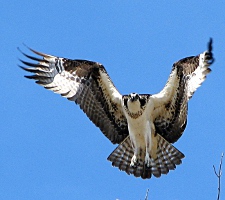 for the female and any offspring. The size of the fish they catch is
quite remarkable, and the Osprey has to be careful not to grab hold of a
fish that is too large for it to lift, because they could get pulled
down into the water and drown - although this is fairly rare. Usually
the bird can loose its grip on a fish that's too big and fly off to try
again another day. From 1940 - 1974 the use of DDT poisoned much of the
fish of North America which consequently wiped out large numbers of
Osprey. Also, lakefront development destroyed much of the Osprey's
natural habitat and nesting sites, forcing them to nest on hazardous
structures like hydro poles and television towers. Fortunately the
Osprey has made a comeback! For many years now there has been a
campaign, headed up by our Ministry of Natural Resources, to build
nesting structures especially for Osprey. You can see them in many
places around Belleville: at the corner of Dundas & Haig, on the north
side of Dundas just east of Haig, at the foot of Reid St. in Memorial
Park, near
for the female and any offspring. The size of the fish they catch is
quite remarkable, and the Osprey has to be careful not to grab hold of a
fish that is too large for it to lift, because they could get pulled
down into the water and drown - although this is fairly rare. Usually
the bird can loose its grip on a fish that's too big and fly off to try
again another day. From 1940 - 1974 the use of DDT poisoned much of the
fish of North America which consequently wiped out large numbers of
Osprey. Also, lakefront development destroyed much of the Osprey's
natural habitat and nesting sites, forcing them to nest on hazardous
structures like hydro poles and television towers. Fortunately the
Osprey has made a comeback! For many years now there has been a
campaign, headed up by our Ministry of Natural Resources, to build
nesting structures especially for Osprey. You can see them in many
places around Belleville: at the corner of Dundas & Haig, on the north
side of Dundas just east of Haig, at the foot of Reid St. in Memorial
Park, near
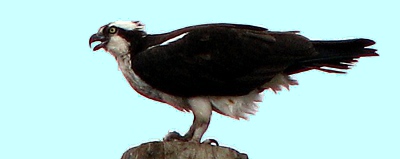 the
bay shore in the Quinte Conservation Area, and at the corner of
Massassauga Rd. and County Road 28 - just to mention a few. These great
birds are easy to see, and captivating to watch.
the
bay shore in the Quinte Conservation Area, and at the corner of
Massassauga Rd. and County Road 28 - just to mention a few. These great
birds are easy to see, and captivating to watch.
THE READER'S PATCH
Two of our
readers,
Tina Pennacchio and Susan Rollinson,
have just opened a new store
for Belleville
birders.
The store is called A PLACE TO PERCH.
It is located at 390 Front Street.
Elaine and I have visited
the store and found it very impressive, with a great selection
of high quality merchandise for those who
enjoy birding in the wild or in their own backyard.
**************************
The Readers
Patch is
a space for your photos, stories, and/or comments.
Send anything
you'd like to share with us to: newsletter@birdingandmore.com
.
The newest addition to our Garden List
.
Yellow-bellied Sapsucker (April 13, 2010)
.
FUN FACTS ABOUT BIRDS
Do you know which bird has the most
feathers?
THE TUNDRA SWAN
With over 25,000 feathers!!
.
What's
New this week
at www.birdingandmore.com
New posts have been added to the Birding and more Blog.
New photos have been added to the Backyard Birds gallery, and the Birds in the Wild gallery.
New entries were also made to the Garden Bird List and to the Links to Other Sites page.
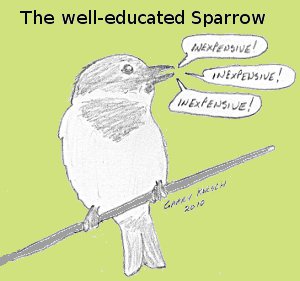
HOW TO
SQUIRREL-PROOF, GRACKLE-PROOF, and STARLING-PROOF your garden instantly,
and for no cost.
Personally, I like squirrels. I think they're incredibly entertaining to watch.
I also think Grackles and Starlings
(in small numbers)
are beautiful birds, but I also appreciate that some people wish that these
"pests" would just stay away. This article will show you a simple, no cost way
to keep them out of your yard.
The problem always begins with feeders full of mixed seed, or peanuts, or suet,
or sunflower seeds, etc. The feeders are intended to attract a variety of
beautiful little birds but instead they are ravaged by Squirrels, Starlings, and
Grackles - and no other birds have a chance. Typically, out of frustration, the
home owner then invests in squirrel baffles, expensive squirrel proof bird
feeders, and even motion detector sprinklers to try to win the war with these
clever and relentless foes. I'm here to tell you there is an easier (and
cheaper) way to do it.
Simply change the food that you put out in your feeders. No more mixed seed,
peanuts and the like. Restrict your feeders to Safflower seed (which Squirrels
and black birds hate), Nyger seed, millet, mealworms, and nectar. A couple of
hopper style feeders with Safflower will attract Cardinals, House Finches,
Chickadees, Doves, and Grosbeaks. Nyger seed in tube feeders is perfect for
Goldfinches, and some of the other small birds. Millet on the ground will make
the Sparrows, Juncos, and Doves happy. Then you have mealworms for the
Bluebirds, and nectar feeders for the Hummingbirds and Orioles. The Robins will
also show up, content to take their fill of earth worms, while the Squirrels,
Grackles and Starlings will have to go elsewhere.
We've planted several shrubs
in our garden just for their appearance and/or fragrance and as I list them here
I realize just how many shrubs we have – and we're not done yet!
![]() I don't know what it is about shrubbery but for me it makes the garden, or at
least plays a major role. For one thing, I do appreciate the privacy shrubs
provide as they grow (and I have to confess I don't understand those who are
I don't know what it is about shrubbery but for me it makes the garden, or at
least plays a major role. For one thing, I do appreciate the privacy shrubs
provide as they grow (and I have to confess I don't understand those who are
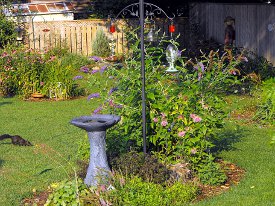
![]() ).
For another, I love the luxuriant green growth, the irregular shape, the flowers
that are so attractive, and the variety of colours and textures of the leaves. I
just love shrubs!
).
For another, I love the luxuriant green growth, the irregular shape, the flowers
that are so attractive, and the variety of colours and textures of the leaves. I
just love shrubs!
As I've mentioned before, we have a Butterfly Bush in our “front” flower
island (the one closest to the patio). It basically grows from scratch each year
(well, last year was its first year of “regrowth” and we have our fingers
crossed for this year) and the flowers are a beautiful deep blue, almost purple.
We also have two Goldflame Spireas, one in each of the islands and a
Bridalwreath Spirea at the back fence (I love the arching branches covered
in white blossoms). The final shrub we have in the front island is a red
Barberry at the base of our feeder pole (it might be a Crimson Pygmy but it was
a shrub that had been planted at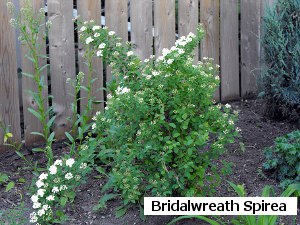
![]() In other locations around the backyard we have a Winter Beauty Dogwood, a
Silverleaf Dogwood, a Hydrangea, and a Pink Cloud Beauty Bush. Last but not
least we have two shrubs at the front of our house, a Smokebush and a Purple
Sandcherry. We wanted different rather than matching but chose shrubs with
leaves of a similar colour and think they will complement each other well.
In other locations around the backyard we have a Winter Beauty Dogwood, a
Silverleaf Dogwood, a Hydrangea, and a Pink Cloud Beauty Bush. Last but not
least we have two shrubs at the front of our house, a Smokebush and a Purple
Sandcherry. We wanted different rather than matching but chose shrubs with
leaves of a similar colour and think they will complement each other well.
I began this article saying that we picked these shrubs for their appearance
and/or fragrance but even without fruit they provide shelter for the birds and
are a valuable part of our bird-friendly garden.
If you liked our newsletter
please pass it along to your friends and family.
Subscriptions are free! Just send an
email to: newsletter@birdingandmore.com
Copyright © 2010 Garry Kirsch www.birdingandmore.com
If you wish to cancel your subscription send an email to unsubscribe@birdingandmore.com
